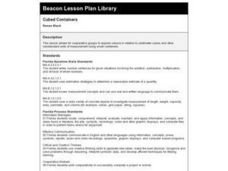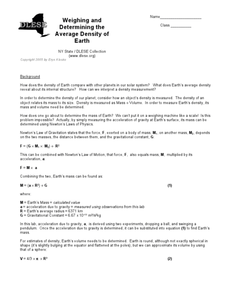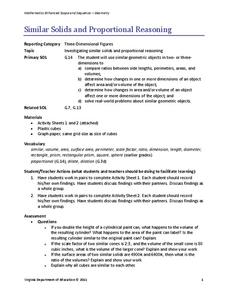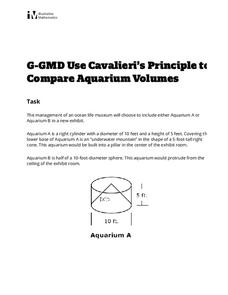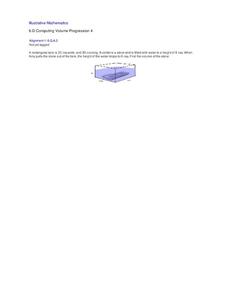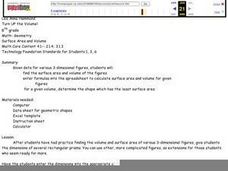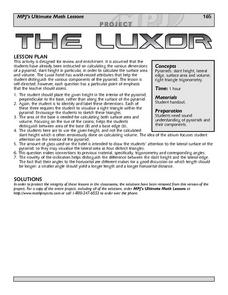Curated OER
Volume
In this volume worksheet, students solve and complete 10 different problems that include determining the volume of books in a library and their weight. First, they complete the table with the weight, number of days and number of boxes...
Curated OER
Decomposing Rectangular Solids
In this surface area and volume worksheet, students solve and complete 3 different decomposing rectangular solids. First, they use the given formulas for surface area and volume to calculate the measurements of each of the illustrated...
Curated OER
Measuring Volume/Capacity Using the Metric System
There is more than one way to measure an amount, as learners discover by applying multiple measurement tools in these activities. Centimeter cubes, cylinders, beakers, and measuring cups are used to find the volume of regular and...
Curated OER
Volume, Mass, and Weight
Study the difference between mass and weight. Your math group will compare the weight of an item to the amount of space that it uses. They'll then use conversion factors to find the difference between kilograms and pounds. Essential...
Curated OER
Using Your Marbles - Volume Measurement and Reporting
Demonstrate how to measure the volume of liquids and solids immersed in liquid to your class. They observe a teacher-led demonstration, and in small groups construct a data table that demonstrates how many marbles were used and the...
Curated OER
Cubed Containers
Learners explore volume in relation to centimeter cubes and other nonstandard units of measurement using small containers. They will use hands-on materials to practice this concept. You will need small objects and containers to set this up.
Curated OER
Making Predictions About Measurement
Upper graders experiment with measurement. They estimate the length, volume, and weight of various objects, then rotate through stations making predictions concerning measurements and then testing their predictions.
Curated OER
Weighing and Determining the Average Density of the Earth
Some background information about density and Newton's Laws of gravitation and motion assist pupils in the following experiment. The procedure will help them further their understanding of gravity, pendulums, and a drop-ball experiment....
Curated OER
Pressure
Some very interesting details about the pressure of gases in our atmosphere are presented in this PowerPoint. Lists of facts about the various laws of gases are summarized and would be a great visual to use during a full lecture.
Virginia Department of Education
Similar Solids and Proportional Reasoning
Double the dimensions, quadruple the surface area. Pairs build similar prisms and compare the ratios of their surface areas and volumes to the ratio of the heights. Given two similar cones, partners determine the ratios of the lateral...
Mr. E. Science
Changes in Matter
Do solids, liquids, and gases even matter? The presentation focuses on changes in matter, including phases, Boyle's Law, Charles' Law, and physical changes.
Illustrative Mathematics
Use Cavalieri’s Principle to Compare Aquarium Volumes
Learners are designing a stunning new water feature for an aquarium, but they soon discover that more than just a pretty home for their fishy friends is required. From calculating the volume of a composite shape through the abstract...
Denton Independent School District
Build a Geome-Tree
Geometers construct a mobile or ornament using nets of three-dimensional polyhedrons. Not only do they need to compute the volume and surface area of each figure, they also earn points for creativity, neatness, and more!
Illustrative Mathematics
Computing Volume Progression 4
This resource was written for the younger math learner, but finding the volume of an irregular solid is also a problem for algebra and geometry learners. Based on Archimedes’ Principle, one can calculate the volume of a stone by...
Curated OER
Turn Up the Volume
Measuring volume can be a mystery for 5th graders, but this hands-on activity gives the gift of discovery. The volume of simple rectangular solids and irregular shapes are calculated through various methods including displacing liquid in...
Curated OER
Titration Results Sheet
There are two identical half-sheets on this page, each including a data table to indicate the outcome of a titration experiment. Chemistry technicians fill in the reagents used, the final and initial volumes of the titration, and the...
Curated OER
Learning About Volume
Learners explore the concept of volume. They develop formulas for volume of prisms. Then use their formulas to find missing dimensions of various prisms such as height, length, width, radius, and diameter.
Curated OER
An Intuitive Introduction to Density
Students complete experiments discovering the relationship between density and mass. They use the internet to gather information before the experiment. They discuss the activity once it is completed.
Curated OER
Popcorn Math
Everyone loves popcorn! Use this treat to teach math concepts including place value, estimating, graphing, and volume. Eight possible activities are included, and they can be modified to fit all grade levels.
Curated OER
Volume and Density Worksheet
All 20 of the problems on the learning exercise involve the computation of cubic volume or density. As long as your young scientists can apply the appropriate mathematical formulas, they will succeed in solving these problems. They are...
Curated OER
What is Sound?
Second graders discuss sound and describe them. In this investigative lesson students observe sound through their eyes, bodies and ears.
Curated OER
The Luxor - Pyramids, Surface Area & Volume
Young scholars investigate the surface area and volume of the Luxor Hotel in Las Vegas. They calculate the slant height, lateral edge, and diagonal length of the base. Using this information, students explore other areas of the hotel,...
Curated OER
Worksheet 37 - Practice Exam III - Integrals
In this integral worksheet, students use double integration to find area and volume. They identify the limits of a sequence. This one-page worksheet contains 11 problems.
Curated OER
Volume Worksheet I
In this volume worksheet, students recognize three-dimensional figures, identify the proper volume formula, and then solve the equation by inserting information from a diagram into the formula. Students solve six equations.







